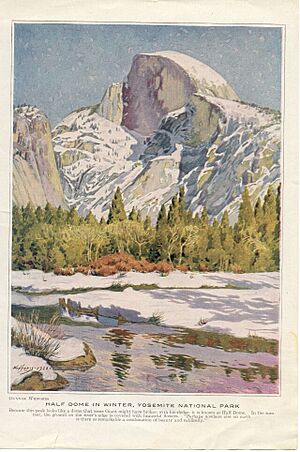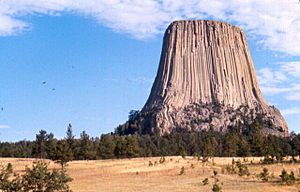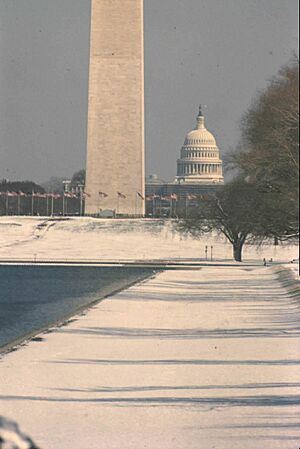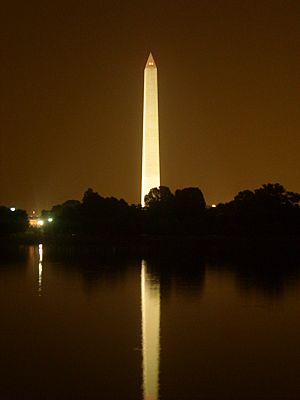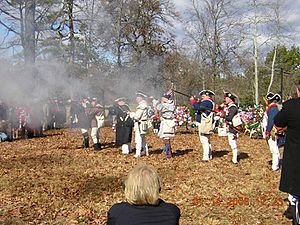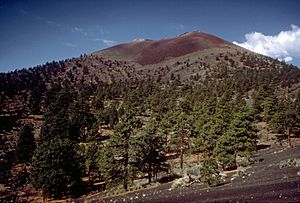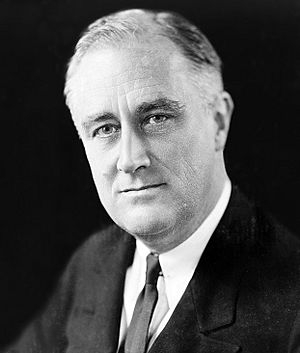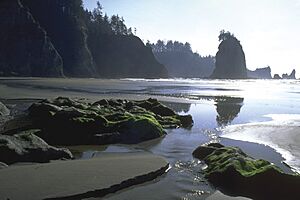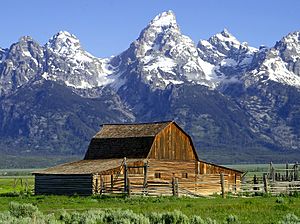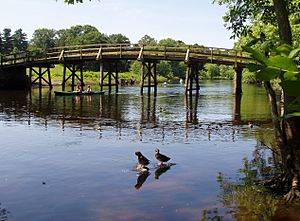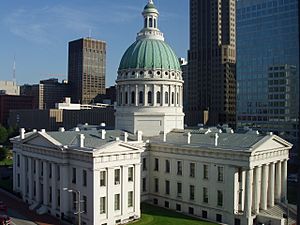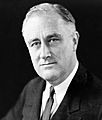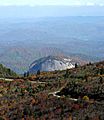History of the National Park Service facts for kids
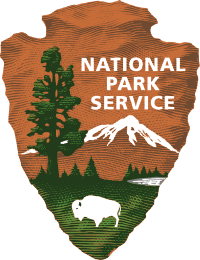
Arrowhead of the National Park Service
|
|
| Agency overview | |
|---|---|
| Formed | 1916 |
| Preceding agency |
|
| Headquarters | Washington, D.C. |
| Employees | 21,000 |
| Parent agency | Department of the Interior |
The National Park System in the United States protects amazing natural and historical places. It started in 1872 with just one park, Yellowstone National Park. Today, it includes 430 special areas across the U.S. and its territories.
These areas are not just National Parks. They also include National Monuments, National Memorials, National Military Parks, and National Historic Sites. There are also National Parkways, National Recreation Areas, National Seashores, and National Scenic Trails.
Contents
How the National Park System Began
Early National Parks: 1864–1891
The idea for national parks came from artist George Catlin. In 1832, he traveled the Great Plains. He worried about nature and Native American cultures being destroyed. He dreamed of "a nation's park" to protect both people and animals.
His idea did not happen right away. But people slowly started to care about saving beautiful natural places.
In California, leaders wanted to protect Yosemite Valley. In 1864, President Abraham Lincoln signed a law. It gave Yosemite Valley and the Mariposa Big Tree Grove to California. The land was to be kept "for the benefit of mankind" forever.
The Yellowstone area was explored between 1869 and 1871. People wanted to protect it from being sold to private owners. The Northern Pacific Railroad Company also helped. They wanted major destinations for their train routes.
To stop poaching and misuse, the U.S. Army set up a fort in Yellowstone in 1881. They began protecting the park. This was the start of park rangers protecting these special places.
In 1875, Mackinac National Park was created in Michigan. It was the second national park. The army also managed this park. In 1895, it was given to the state.
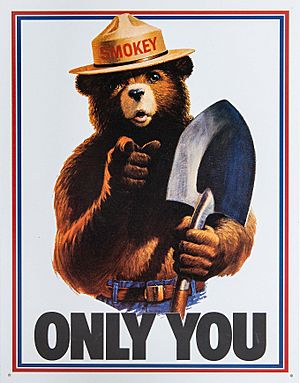
U.S. cavalry units helped manage Yosemite Park in 1891. In 1906, the park became fully controlled by the federal government. These soldiers wore campaign hats. This hat became a symbol of authority. Park rangers and other law enforcement agencies later adopted it.
National Monuments: 1906–1916
People also wanted to save ancient cliff dwellings and ruins in the West. Ranchers tried to protect them, but many sites were vandalized. This led to the Antiquities Act of 1906.
This act allowed the President to declare historic places as National Monuments. It also stopped people from digging up or taking objects from federal land without a permit.
President Theodore Roosevelt signed the Antiquities Act on June 8, 1906. On September 24, 1906, he named Devils Tower in Wyoming the first National Monument. It is a 600-foot (180 m) rock tower.
Later that year, three more monuments were created: El Morro in New Mexico, Montezuma Castle in Arizona, and Petrified Forest in Arizona. Some of these monuments later became National Parks.
Mineral Springs: 1832–1916
People have used mineral springs for health for a long time. In 1832, Hot Springs, Arkansas, was set aside by the government. This was to protect its 47 hot springs. In 1921, it became a National Park. It is more of a health resort than a scenic area.
In 1906, Congress created Platt National Park in Oklahoma. It included the Sulphur Springs Reservation.
The National Park Service is Created (1916)
Forty-four years after Yellowstone was established, President Woodrow Wilson created the National Park Service. This happened on August 25, 1916. Many people worked hard to create a special agency to manage all the National Parks and Monuments.
Big Changes in 1933
On June 11, 1933, President Franklin D. Roosevelt made a big change. He combined all National Parks, National Monuments, and other federal parks into one system. The National Park Service was put in charge of all of them.
This change had three main results:
- The National Park Service became the only federal agency managing all public parks and monuments.
- The idea of the "National Park System" grew. It now included National Memorials (like the Washington Monument), National Military Parks (like Gettysburg), and city parks (like National Capital Parks).
- The number of areas in the system greatly increased. Many natural and historical sites were added.
National Capital Parks: 1790–1933
The National Capital Parks are the oldest parks in the system. They began when Washington, D.C. was founded in 1790. President George Washington hired Pierre Charles L'Enfant to design the city. His plan included many parks and boulevards, like The Mall.
Rock Creek Park was authorized in 1890. It was set aside "for the benefit and enjoyment of the people." It was meant to keep nature "in their natural condition."
National Memorials: 1776–1933
The first memorial was planned in 1776. It was to honor General Richard Montgomery. He died fighting in Quebec during the Revolutionary War.
The Washington Monument was started in 1848. It was built to honor George Washington. The Civil War slowed its progress. In 1876, Congress took over its completion. It was dedicated on February 21, 1885.
In 1933, these National Memorials joined the National Park System.
National Military Parks: 1781–1933
The first battlefield monument was authorized in 1781. It was for the surrender at Yorktown, Virginia. Later, monuments were built at other Revolutionary War battlefields.
After the Civil War, people wanted to remember important battles. In 1890, Congress created the first four National Military Parks. These included Chickamauga & Chattanooga and Gettysburg. These parks were meant to preserve battlefields for study and as memorials.
In 1933, all these military parks were transferred to the National Park Service. They became a special part of the system.
National Cemeteries: 1867–1933
National Cemeteries are linked to military parks. After the battle of Gettysburg, many soldiers died. Governor Andrew Y. Curtin of Pennsylvania helped create a cemetery for them.
William Saunders designed the Gettysburg National Cemetery. It was dedicated by President Abraham Lincoln on November 19, 1863. Lincoln's famous Gettysburg Address made this spot very important.
In 1867, Congress created a system of National Cemeteries. Eleven of these were added to the National Park System in 1933.
More National Monuments: 1906–1933
The Antiquities Act of 1906 allowed the President to create National Monuments on military lands. Between 1906 and 1933, ten such monuments were created. These included Big Hole National Battlefield, Cabrillo National Monument, and the Statue of Liberty.
Presidents also created 21 National Monuments on National Forest lands. These were managed by the U.S. Department of Agriculture.
Some examples include:
- Lassen Peak, California (later part of Lassen Volcanic National Park)
- Gila Cliff Dwellings National Monument, New Mexico
- Grand Canyon (later Grand Canyon National Park)
- Mount Olympus, Washington (later Olympic National Park)
These monuments protected unique natural features and scientific objects.
Growth of the System: 1933–1966
After 1933, the National Park Service had to manage many new areas. President Franklin D. Roosevelt started the Civilian Conservation Corps (CCC). This program helped conserve natural resources. The CCC built many things in parks, like trails and buildings.
By the mid-1900s, parks needed a lot of repairs and new developments. This led to "Mission 66." It was a plan to improve parks for their 50th anniversary in 1966.
Between 1933 and 1964, 102 new areas were added. The number of historical and recreation areas grew much faster than natural areas.
New Natural Areas: 1933–1966
Many important natural areas were added during this time. Some examples include:
- Everglades N.P. in Florida (1934)
- Big Bend N.P. in Texas (1935)
- Olympic N.P. in Washington (1938)
- Grand Teton N.P. in Wyoming (1950)
Jackson Hole in Wyoming was a special case. John D. Rockefeller Jr. bought over 33,000 acres (130 km2) of land there. He wanted to protect it from development. He offered it as a gift to the U.S. government.
However, some local people and politicians were against it. In 1943, President Roosevelt created the Jackson Hole National Monument. This combined Rockefeller's land with other federal land. After more debate, it became part of a "new Grand Teton National Park" in 1950.
New Historical Areas: 1933–1966
Seventy-five historical areas were added. This was helped by the Historic Sites Act of 1935. This act made it a national goal to preserve historic sites.
The National Park Service was given powers to:
- Find historic and archaeological sites.
- Buy property for preservation.
- Work with states and other groups to protect historic places.
One important addition was Gateway Arch National Park in St. Louis. It was the first major effort to save a large urban historic site. It includes the famous Eero Saarinen's stainless steel Arch.
Another key project was Independence National Historical Park in Philadelphia. It includes Independence Hall and other sites important to U.S. independence. Other urban historical parks were added in Boston and New York City.
The Historic American Buildings Survey started in 1933. It collects drawings, photos, and documents of historic buildings. The National Survey of Historic Sites and Buildings also began. It recommends places to become National Historic Landmarks.
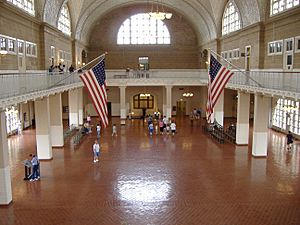
.
The Inter-Agency Archaeological Salvage Program started in 1946. It saves ancient artifacts from areas that will be flooded by new dams.
New Recreation Areas: 1933–1966
The National Park Service also started four new types of federal park areas: National Parkways, National Recreation Areas, National Seashores, and Recreational Demonstration Areas.
|
National Parkways
National Seashores
|
Recreational Demonstration Areas
Reservoir-related Recreation Areas
|
The National Park Service helped states create their own parks. They also managed hundreds of Civilian Conservation Corps (CCC) camps in state parks.
National Parkways are scenic roads for leisurely travel. The Blue Ridge Parkway is a famous example. It connects Shenandoah National Park and Great Smoky Mountains National Park. It offers beautiful views and shows mountain culture. The Natchez Trace Parkway follows an old Indian path and historic road.
Recreational Demonstration Areas were lands bought by the government. They were used for outdoor recreation, especially for people from cities. Catoctin Mountain Park and Prince William Forest Park are examples that stayed with the National Park Service.
Reservoir-related Recreation Areas were created around large dams. Lake Mead was the first, formed by Hoover Dam. These areas offer water-based recreation.
National Seashores protect unspoiled coastlines. Cape Hatteras National Seashore in North Carolina was the first. Later, Point Reyes National Seashore in California and Padre Island National Seashore in Texas were added.
The Second 50 Years: 1966–2016
The 1960s brought more public interest in America's natural and historical places. President Lyndon B. Johnson wanted "parks for people." Director George B. Hartzog Jr. supported making parks more accessible.
Redwood Amendment
In 1970, Congress clarified the mission of the National Park Service. The "Redwood amendment" in 1979 further explained it. It stated that the National Park System includes "superlative natural, historic, and recreation areas." These areas are managed "for the benefit and inspiration of all the people."
National Lakeshores
The first national lakeshores were created in 1966. They protected unique coastlines of the Great Lakes. These included Pictured Rocks National Lakeshore and Indiana Dunes National Lakeshore.
National Heritage Areas
Heritage areas identify regions with a common cultural impact. The Potomac Heritage National Scenic Trail was established in 1983. These areas help preserve and share local history and culture.
Urban Recreation Areas
During President Richard Nixon's time, more parks were created in cities. Golden Gate National Recreation Area in San Francisco and Gateway National Recreation Area in New York City were examples. They provided open space for major urban areas.
In 1978, the Chattahoochee River National Recreation Area was created near Atlanta. It includes 15 park units along 48 miles (77 km) of the Chattahoochee River.
The Alaska Expansion
In 1977, President Jimmy Carter created many national monuments in Alaska. This led to the Alaska National Interest Lands Conservation Act (ANILCA). This act set aside huge amounts of land for the National Park System and wildlife refuges.
It created or expanded many famous parks. These include Denali National Park, Wrangell–St. Elias National Park and Preserve, and Glacier Bay National Park and Preserve.
New Parks Under Presidents Reagan, Bush, and Clinton
Presidents Ronald Reagan, George H. W. Bush, and Bill Clinton continued to add new units. These additions included a variety of natural and historical sites across the country.
For example, under Reagan, new units like Hagerman Fossil Beds National Monument in Idaho and National Park of American Samoa were added.
Under George H. W. Bush, new units like Dry Tortugas National Park in Florida and Brown v. Board of Education National Historic Site in Kansas were created.
Under Clinton, new units like Rosie the Riveter / World War II Home Front National Historical Park in California and Minuteman Missile National Historic Site in South Dakota were added. Some existing monuments were also redesignated as National Parks, like Cuyahoga Valley National Park and Black Canyon of the Gunnison National Park.
New Parks Under Presidents George W. Bush and Obama
Presidents George W. Bush and Barack Obama also added many new units.
Under George W. Bush, new units included the African Burial Ground National Monument in New York and the Flight 93 National Memorial in Pennsylvania. Some parks were also renamed or redesignated.
Under Barack Obama, 26 new units were approved. These included Reconstruction Era National Monument in South Carolina and Stonewall National Monument in New York. Many historical sites related to civil rights and women's equality were also added.
New Parks Under President Trump
President Donald Trump approved 5 new National Park Units. Some existing sites were also renamed or redesignated.
For example, New River Gorge National Park and Preserve in West Virginia was renamed from a National River. White Sands National Park in New Mexico was redesignated from a National Monument.
Images for kids
-
Smokey Bear wears a forest ranger style campaign hat
-
Old North Bridge, Minute Man National Historical Park in Massachusetts
-
The Old Courthouse, part of the Gateway Arch National Park in Missouri
-
Ellis Island's main hall
-
Looking back at the Point Reyes headlands from the Chimney Rock trail in winter. Elephant seals lie in the sand at the bottom of the cliffs. Point Reyes National Seashore
See also
 In Spanish: Sistema de Parques Nacionales de los Estados Unidos para niños
In Spanish: Sistema de Parques Nacionales de los Estados Unidos para niños


